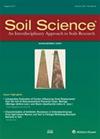Soil and crop management practices and the water regulation functions of soils: a qualitative synthesis of meta-analyses relevant to European agriculture
4区 农林科学
Q2 Agricultural and Biological Sciences
引用次数: 4
Abstract
Abstract. Adopting soil and crop management practices that conserve or enhance soil structure is critical for supporting the sustainable adaptation of agriculture to climate change, as it should help maintain agricultural production in the face of increasing drought or water excess without impairing environmental quality. In this paper, we evaluate the evidence for this assertion by synthesizing the results of 34 published meta-analyses of the effects of such practices on soil physical and hydraulic properties relevant for climate change adaptation in European agriculture. We also review an additional 127 meta-analyses that investigated synergies and trade-offs or help to explain the effects of soil and crop management in terms of the underlying processes and mechanisms. Finally, we identify how responses to alternative soil–crop management systems vary under contrasting agro-environmental conditions across Europe. This information may help practitioners and policymakers to draw context-specific conclusions concerning the efficacy of management practices as climate adaptation tools. Our synthesis demonstrates that organic soil amendments and the adoption of practices that maintain “continuous living cover” result in significant benefits for the water regulation function of soils, mostly arising from the additional carbon inputs to soil and the stimulation of biological processes. These effects are clearly related to improved soil aggregation and enhanced bio-porosity, both of which reduce surface runoff and increase infiltration. One potentially negative consequence of these systems is a reduction in soil water storage and groundwater recharge, which may be problematic in dry climates. Some important synergies are reductions in nitrate leaching to groundwater and greenhouse gas emissions for nonleguminous cover crop systems. The benefits of reducing tillage intensity appear much less clear-cut. Increases in soil bulk density due to traffic compaction are commonly reported. However, biological activity is enhanced under reduced tillage intensity, which should improve soil structure and infiltration capacity and reduce surface runoff and the losses of agro-chemicals to surface water. However, the evidence for these beneficial effects is inconclusive, while significant trade-offs include yield penalties and increases in greenhouse gas emissions and the risks of leaching of pesticides and nitrate. Our synthesis also highlights important knowledge gaps on the effects of management practices on root growth and transpiration. Thus, conclusions related to the impacts of management on the crop water supply and other water regulation functions are necessarily based on inferences derived from proxy variables. Based on these knowledge gaps, we outlined several key avenues for future research on this topic.土壤和作物管理实践和土壤的水调节功能:与欧洲农业相关的荟萃分析的定性综合
摘要采用保护或加强土壤结构的土壤和作物管理做法对于支持农业可持续适应气候变化至关重要,因为它应有助于在面临日益严重的干旱或水资源过剩的情况下保持农业生产,同时不损害环境质量。在本文中,我们通过综合34项已发表的荟萃分析结果来评估这一论断的证据,这些荟萃分析是关于此类做法对欧洲农业中与气候变化适应相关的土壤物理和水力特性的影响。我们还回顾了另外127项荟萃分析,这些分析调查了协同作用和权衡,或有助于解释土壤和作物管理在潜在过程和机制方面的影响。最后,我们确定了在欧洲不同的农业环境条件下,对替代土壤作物管理系统的反应是如何变化的。这些信息可以帮助从业者和决策者就管理实践作为气候适应工具的有效性得出具体情况下的结论。我们的综合研究表明,有机土壤改良和采用保持“连续生物覆盖”的做法对土壤的水调节功能有显著的好处,主要来自土壤的额外碳输入和生物过程的刺激。这些效应明显与土壤聚集性的改善和生物孔隙度的增加有关,两者都减少了地表径流,增加了入渗。这些系统的一个潜在负面后果是减少土壤储水量和地下水补给,这在干燥气候下可能会造成问题。一些重要的协同作用是减少硝酸盐对地下水的淋滤和非豆科覆盖作物系统的温室气体排放。减少耕作强度的好处似乎不那么明确。由于交通压实导致的土壤容重增加是常见的报道。然而,减少耕作强度可以增强生物活性,从而改善土壤结构和入渗能力,减少地表径流和农用化学品对地表水的损失。然而,这些有益影响的证据是不确定的,而重要的权衡包括产量损失和温室气体排放的增加以及农药和硝酸盐浸出的风险。我们的综合还突出了管理实践对根系生长和蒸腾作用影响方面的重要知识空白。因此,有关管理对作物供水和其他水调节功能的影响的结论必须基于代理变量的推断。基于这些知识差距,我们概述了未来研究该主题的几个关键途径。
本文章由计算机程序翻译,如有差异,请以英文原文为准。
求助全文
约1分钟内获得全文
求助全文
来源期刊

Soil Science
农林科学-土壤科学
CiteScore
2.70
自引率
0.00%
发文量
0
审稿时长
4.4 months
期刊介绍:
Cessation.Soil Science satisfies the professional needs of all scientists and laboratory personnel involved in soil and plant research by publishing primary research reports and critical reviews of basic and applied soil science, especially as it relates to soil and plant studies and general environmental soil science.
Each month, Soil Science presents authoritative research articles from an impressive array of discipline: soil chemistry and biochemistry, physics, fertility and nutrition, soil genesis and morphology, soil microbiology and mineralogy. Of immediate relevance to soil scientists-both industrial and academic-this unique publication also has long-range value for agronomists and environmental scientists.
 求助内容:
求助内容: 应助结果提醒方式:
应助结果提醒方式:


